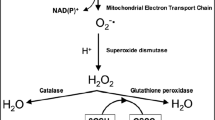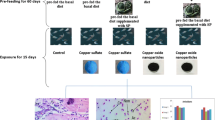Abstract
Tilapias (Oreochromis niloticus) were exposed to copper or chromium in soft water (SW) (~80 mg CaCO3/L, conductivity 1.77 mS/cm) or hard water (HW) (~320 mg CaCO3/L, conductivity 5.80 mS/cm) using 2 exposure protocols (20 μM for 48 h and 10 μM for 144 h). Following the exposures, antioxidant enzyme activities [superoxide dismutase (SOD); catalase (CAT); glutathione peroxidase; glutathione reductase; and glutathione S-transferase (GST)] and glutathione (GSH) levels were measured in the liver of fish. SOD and CAT activities of control fish kept in SW were significantly lower than control fish kept in HW. However, the other antioxidant indices (glutathione metabolism) of both control fish were unaffected from water hardness. Acute metal exposures did not alter the glutathione metabolism, whereas SOD activity in SW and CAT activity in both waters changed significantly. In subchronic duration, Cu exposure caused significant decreases in measured parameters, except for GST activity and GSH level. Similarly, GST activity and GSH level were unaffected from Cr exposure. This study showed that SOD and CAT were the most sensitive antioxidant indices, and that glutathione metabolism, in general, was not altered following metal exposures in different waters.






Similar content being viewed by others
References
Atli G, Canli M (2007) Enzymatic responses to metal exposures in a freshwater fish Oreochromis niloticus. Comp Biochem Physiol Part C 145:282–287
Atli G, Canli M (2008) Responses of metallothionein and reduced glutathione in a freshwater fish Oreochromis niloticus following metal exposures. Environ Toxicol Pharmacol 25:33–38
Atli G, Canli M (2010) Response of antioxidant system of freshwater fish Oreochromis niloticus to acute and chronic metal (Cd, Cu, Cr, Zn, Fe) exposures. Ecotoxicol Environ Saf 73:1884–1889
Atli G, Alptekin Ö, Tükel S, Canli M (2006) Response of catalase activity to Ag+, Cd2+, Cr6+, Cu2+ and Zn2+ in five tissues of freshwater fish Oreochromis niloticus. Comp Biochem Physiol 143C:218–224
Avci A, Kaçmaz M, Durak I (2005) Peroxidation in muscle and liver tissues from fish in a contaminated river due to a petroleum refinery industry. Ecotoxicol Environ Saf 6:101–105
Barata C, Varob I, Navarro JC, Arun S, Porte C (2005) Antioxidant enzyme activities and lipid peroxidation in the freshwater cladoceran Daphnia magna exposed to redox cycling compounds. Comp Biochem Physiol 140C:175–186
Baysoy E, Atli G, Gürler CÖ, Dogan Z, Eroglu A, Kocalar K, Canli M (2012) The effects of increased freshwater salinity in the biodisponibility of metals (Cr, Pb) and effects on antioxidant systems of Oreochromis niloticus. Ecotoxicol Environ Saf 84:249–253
Chandran R, Sivakumar AA, Mohandass S, Aruchami M (2005) Effect of cadmium and zinc on antioxidant enzyme activity in the gastropod, Achatina fulica. Comp Biochem Physiol 140C:422–426
Dautremepuits C, Paris-Palacios S, Betoulle S, Vernet G (2004) Modulation in hepatic and head kidney parameters of carp (Cyprinus carpio L.) induced by copper and chitosan. Comp Biochem Physiol 137C:325–333
Donham RT, Morin D, Tjeerdema RS (2006) Salinity effects on the activity and expression of glutathione S-transferases in White sturgeon and Chinook salmon. Ecotoxicol Environ Saf 63:293–298
Ercal N, Gurer-Orhan H, Aykin-Burns N (2001) Toxic metals and oxidative stress part I: mechanisms involved in induced oxidative damage. Curr Top Med Chem 1:529–539
Falfushynska HI, Stolyar OB (2009) Responses of biochemical markers in carp Cyprinus carpio from two field sites in Western Ukraine. Ecotoxicol Environ Saf 72:729–736
Gorbi S, Baldini C, Regoli F (2005) Seasonal variability of metallothioneins, cytochrome P450, bile metabolites and oxyradical metabolism in the European eel Anguilla anguilla L. (Anguillidae) and striped mullet Mugil cephalus L. (Mugilidae). Arch Environ Contam Toxicol 49:62–70
Grosell M, Nielsen C, Bianchini A (2002) Sodium turnover rate determines sensitivity to acute copper and silver exposure in freshwater animals. Comp Biochem Physiol 133C:287–303
Heath AG (1995) Water pollution and fish physiology. CRC Press, Florida
Jena KB, Verlecar XN, Chainy GBN (2009) Application of oxidative stress indices in natural populations of Perna viridis as biomarker of environmental pollution. Mar Pollut Bull 58:107–113
Loro VL, Jorge MB, Silva KR, Wood CM (2012) Oxidative stress parameters and antioxidant response to sublethal waterborne zinc in a euryhaline teleost Fundulus heteroclitus: protective effects of salinity. Aquat Toxicol 110–111:187–193
Lushchak OV, Kubrak OI, Nykorak MZ, Storey KB, Lushchak VI (2008) The effect of potassium dichromate on free radical processes in goldfish: possible protective role of glutathione. Aquat Toxicol 87:108–114
Maret W (2011) Redox biochemistry of mammalian metallothioneins. J Biol Inorg Chem 16:1079–1086
Martinez-Alvares RM, Morales AE, Sanz A (2005) Antioxidant defenses in fish: biotic and abiotic factors. Rev Fish Biol Fish 15:75–88
Meyer JN, Smith JD, Winston GW, Di Giulio RT (2003) Antioxidant defenses in killifish (Fundulus heteroclitus) exposed to contaminated sediments and model prooxidants: short-term and heritable responses. Aquat Toxicol 65:377–395
Monserrat JM, Martinez PE, Geracitano LA, Amado LL, Martins CMG, Pinho GLL, Chaves ISC, Ferreira-Cravo M, Ventura-Lima J, Bianchini A (2007) Pollution biomarkers in estuarine animals: critical review and new perspectives. Comp Biochem Physiol 146C:221–234
Niyogi S, Biswas S, Sarker S, Datta AG (2001) Seasonal variation of antioxidant and biotransformation enzymes in barnacle, Balanus balanoides, and their relation with polyaromatic hydrocarbons. Mar Environ Res 52:13–26
Oner M, Atli G, Canli M (2008) Changes in serum biochemical parameters of freshwater fish Oreochromıs niloticus following prolonged metal (Ag, Cd, Cr, Cu, Zn) exposures. Environ Toxicol Chem 27:360–366
Pinto E, Sigaud-Kutner TCS, Leitao MAS, Okamoto OK, Morse D, Colepicolo P (2003) Heavy metal-induced oxidative stress in algae. J Phycol 39:1008–1018
Pruell RJ, Engelhardt FR (1980) Liver cadmium uptake, catalase inhibition and cadmium thionein production in the killifish (Fundulus Heteroclitus) induced by experimental cadmium exposure. Mar Environ Res 3:101–111
Radi AAR, Matkovics B (1988) Effects of metal ions on the antioxidant enzyme activities, protein contents and lipid peroxidation of carp. Comp Biochem Physiol 90C:69–72
Romeo M, Bennani N, Gnassia-Barelli M, Lafaurie M, Girard JP (2000) Cadmium and copper display different responses towards oxidative stress in the kidney of the sea bass Dicentrarchus labrax. Aquat Toxicol 48:185–194
Saglam D, Atli G, Canli M (2013) Investigations on the osmoregulation of freshwater fish (Oreochromis niloticus) following exposures to metals (Cd, Cu) in differing hardness. Ecotoxicol Environ Saf 92:79–86
Verlecar XN, Jena KB, Chainy GBN (2007) Biochemical markers of oxidative Perna viridis exposed to mercury and temperature. Chem Biol Interact 167:219–226
Acknowledgments
This study was supported by Research Fund of Çukurova University (Grant No. FEF2010BAP14).
Author information
Authors and Affiliations
Corresponding author
Rights and permissions
About this article
Cite this article
Dogan, Z., Eroglu, A., Kanak, E.G. et al. Response of Antioxidant System of Tilapia (Oreochromis niloticus) Following Exposure to Chromium and Copper in Differing Hardness. Bull Environ Contam Toxicol 92, 680–686 (2014). https://doi.org/10.1007/s00128-014-1245-2
Received:
Accepted:
Published:
Issue Date:
DOI: https://doi.org/10.1007/s00128-014-1245-2




